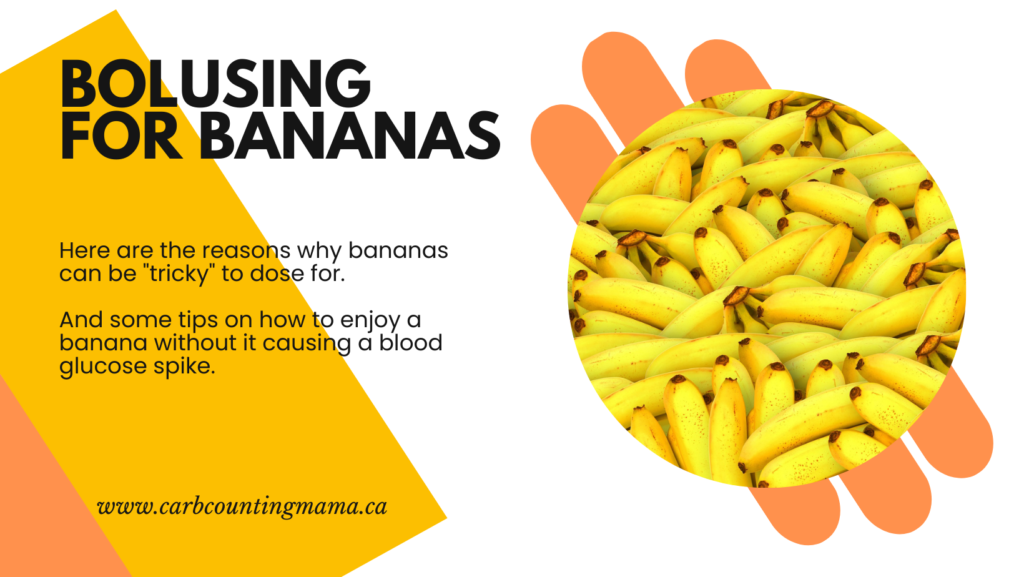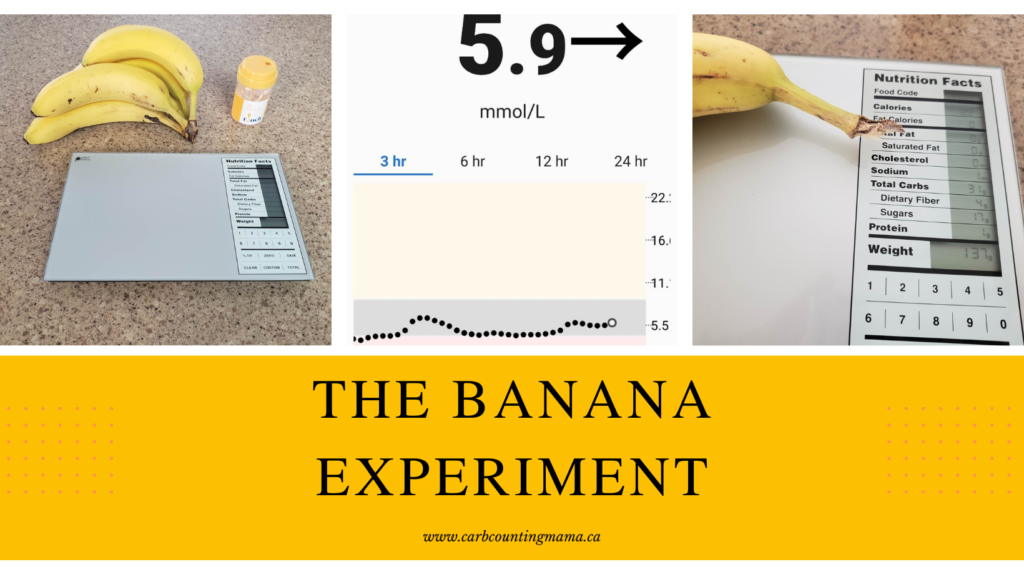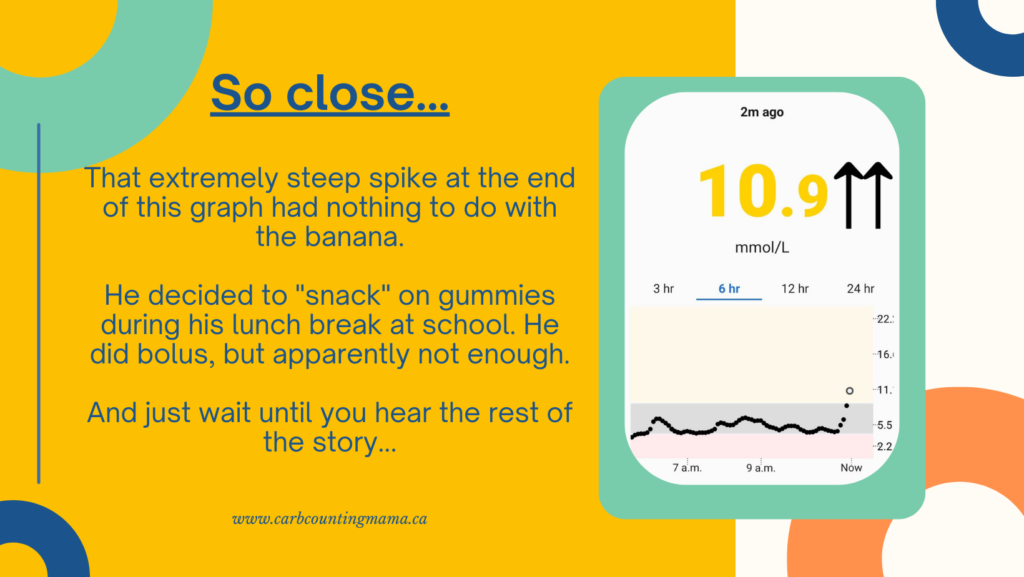Often, people with T1D find bananas cause spikes in bg. So much so that many people stop eating bananas altogether. They are definitely a tricky food to dose for. Let’s talk about why they are so tricky, what we can do about it, and see if we can figure out how to eat them without the dreaded bg spike.

This post contains affiliate links
I am not a doctor or medical professional. This article is for informational purposes only. If you are thinking about changing the way you treat your diabetes, consult your medical team for assistance.
Why are bananas such a tricky food?
On the surface, it can be surprising that bananas are tricky to dose for. They’re healthy, aren’t they?
Fruit is good for you. It’s full of nutrients and fiber. Bananas are a great source of potassium and they’re a favorite snack even among picky eaters.
But it can be difficult to figure out an accurate carb count for bananas. Here’s why:
How many carbs are in a banana?
Many people have a set number that they use to dose for bananas. There are a couple of problems with that.
- Bananas vary quite a bit in size. A bigger banana is going to have more carbs than a smaller banana.
- The numbers that I’ve seen people use range from about 15 grams of carbs to 40 grams of carbs per banana. That means, even setting aside the size difference from banana to banana, some people are using more accurate numbers than other people.
Both of those points boil down to the same thing… people are often using incorrect carb counts when they’re dosing for bananas.
If you’re using an incorrect carb count, plunking that number into your ICR is not going to work out properly.
Ideally, to get an accurate carb count, you want to weigh the banana and use a carb factor or nutrition scale code.
Even if you’re using a carb factor
The carb factors for fruit aren’t exact. But if you look online, the carb factor for bananas without the peel is approximately 0.20, and with the peel, it’s approximately 0.14.
I say approximately because there are varying carb factors depending on where you look. Some of that variability is likely due to fiber. Some people subtract it while others don’t. But the numbers I’ve listed above are the most commonly mentioned on several different websites.
It’s important to make sure that the code or carb factor that you’re using is for what you’re measuring. You don’t want to use a carb factor for “peeled banana” if you’re leaving the peel on.
This brings me to my next point. It’s slightly more accurate to use a carb factor for a peeled banana rather than one that’s still in the peel. Of course, there are situations where it makes sense to leave the peel on (like school lunch for instance), and lots of people prefer to eat bananas from the peel. It’s just another thing to keep in mind for your bolus amount.
Rather than picking an arbitrary number of carbs to dose for, it’s much more accurate to weigh your bananas. You can even do it ahead of time and “write” the number on the peel with a toothpick or sharpie. That way, the bananas are ready to grab and go!
If you don’t have a food scale, I recommend this one: Greater Goods Nutrition Scale
Green, yellow, or brown?
Another big reason why bananas are tricky to dose for is their nutrition changes as they ripen. Unripe bananas have a lot of starch in them. This still breaks down into glucose in our bodies, but it takes longer. So, a less ripe banana will not cause a steep spike like a yellow or brownish one might.
As they ripen, most of the starch converts into sugar (mostly sucrose, fructose, and glucose).
It’s not the carb count that changes, but the glycemic index. As bananas ripen, they move up on the glycemic index. As you can see, Diabetes Canada even puts different ripenesses of bananas into different GI categories in their Glycemic Index Food Guide.
Basically, the ripeness of your banana is going to affect your pre-bolus timing.
With all of that in mind, Jordan and I are going to test our “T1D skills” and see if we can have him successfully eat a banana without seeing a spike (or drop) in bg.
Some important info before we start:
- Before starting, we did a basal test and tested Jordan’s breakfast carb ratio. Both are accurate for his day-to-day life.
- Jordan currently manages his T1D with MDI. He tends to dose for food using his stomach as his injection site (yes, the location of the insulin injection is important for this experiment).
- The insulins he uses are Tresiba (which is considered to be an ultra-long-acting insulin with no discernable peak) and Fiasp (which is an ultra-rapid-acting insulin that starts working within a few minutes and has a duration similar to other rapid-acting insulins).
This may be similar to the way you manage T1D, or it might be very different. Different insulins and management methods will change the way all of this works. Even if you do things exactly the same way that Jordan and I do, this might not work the same for you. It’s meant as a demonstration not any kind of T1D instructions.
The goal:
Accurately dose for a banana so that there is no significant spike or dip in bg numbers.
The plan:
Jordan doesn’t eat bananas very often. I don’t have a specific “method” that we use. But, based on everything that I’ve already talked about, I can make a tentative plan.
As always, ideally, we want to start off with steady and in-range numbers. It just takes some of the guesswork out of the equation. And of course, it’s healthier for him in general.
Bananas have a fair amount of carbs with very little protein and fat. We actually tend to have very good luck with foods that have that macro profile. So, I’m planning on doing what we usually do. Get an accurate carb count, use his recently tested ICR, and dose right before he starts eating (I would pre-bolus if he was using a different kind of insulin, but he uses Fiasp which works really quickly).
Bolusing for bananas Attempt #1

It’s a school day. Jordan has math class first, so he won’t be very active. We walk to school, which is about a 20-minute walk. He tends to get up right before we have to leave, so I’m hoping that the walk will help curb any spike that the banana might cause.
I weighed the banana in the peel. As you can see in the picture above, I tried to use the code for bananas in our nutrition scale book. Clearly, it’s for peeled bananas as it gave me an incorrect carb count. So, I multiplied the weight by the carb factor 0.14. The banana has approximately 19 grams of carbs in it. It’s getting some brown spots, so that might cause a spike… we’ll see.
His bg was 5.9 (106 in mg/dl). So we won’t be doing a correction. His ICR is 1:6 right now. That would be 3.2 units, but we can only do increments of 0.5 which means rounding up or down. Or… doing what Jordan does, having a small candy with his banana to round up the carb count and give 4 units of insulin.
He ate the candy, dosed his 4 units of insulin, ate the banana, and then we were out the door for our walk to school.
3 hours later…

Alright, there are two parts to this story.
First, the banana bolus went surprisingly well and there was no spike or dip in his blood sugar whatsoever. Yay us! We figured out a solid plan to bolus for his banana and it worked!
But, let me show you what happened after that…
I was about to grab a screenshot of how our banana experiment went when my high alarm went off. I was shocked to see how steep the spike was. Clearly, he had eaten something.
I texted him and asked what was going on
So, Jordan is a teenager in high school. And during his lunch break, he decided that he was going to eat gummies. I have no idea how many or what kind. I don’t know how much he bolused for or what the carb count was. What I do know is that he didn’t bolus enough.
And the second part of his text was, “I’m out of needle tips”. Yikes!
Don’t worry, all is well. I went to the school with more needle tips and he bolused. He had a rebound low and was on the roller coaster for a few hours. His bg has finally evened out again and he’s sitting at 4.6 (83 mg/dl).
This has nothing to do with bananas
But it’s important. Because when we’re 100% on top of things, his bg is great. When we get accurate carb counts and take a minute to consider factors such as activity and insulin timing, it makes a huge difference.
And then there are times when I’m not on top of it. When he does frustrating, but normal, teenager stuff. When neither of us is giving 100% and things go haywire.
Real life happens. Sometimes we nail the bolus for a banana and other times we end up on a roller coaster because of a few gummies.
But the more we practice being intentional about how we calculate and dose, the more frequently we’ll have non-diabetic numbers.
Bananas can be tricky to bolus for
But here are a few takeaways:
- Accurate carb counts are really important. So many people have a set number of carbs for bananas or guess at it. Guessing and SWAGging are surefire ways to mess up a bolus.
- Having your settings dialed in really helps. If you’ve basal tested and know that your ICR is working, that makes all the difference.
- Activity can be a tool for T1D management. I do believe his walk to school helped to curb whatever spike we might have seen if he wasn’t active right after eating. Alternatively, if we find ourselves in a situation where he’s low-ish and wants to do something active, eating a banana right before might be helpful to keep his bg steady.
- If it doesn’t go well the first time, examine what happened and tweak your plan for next time. There’s no need to eliminate entire foods from your diet.
Maybe later when we do a similar experiment with smoothies and fruit salad, it will be trickier. One banana by itself is a lot easier to figure out than a mixture of several things. But it’s helpful to understand how bananas digest and how to dose for them by themselves. That way, even when we add other things to the mix, we have a good starting point for a plan on how to bolus.
~ Leah
What are your thoughts on bolusing for bananas? Is it straightforward? Does it make you feel like it’s impossible? Let’s discuss it. Leave a comment below!
For more tips and stories about T1D, join the Carb Counting Mama email list, and make sure to head over to the Carb Counting Mama Facebook page and “like” it.
Leave a Reply